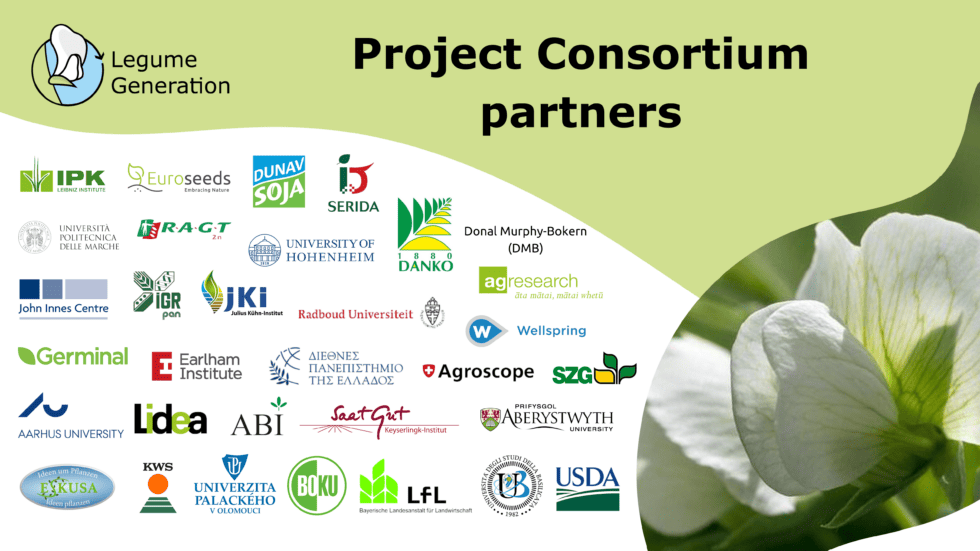Legume Generation is working to reduce the protein gap and protein deficiency in Europe.
According to agricultural experts, Europe needs better legumes so that farmers can meet the demand for plant protein and support the protein transition. Against this background, 50 scientists and plant breeders met recently Leibniz Institute for Plant Genetics and Crop Plant Research (IPK) in Gatersleben/Germany. They are members of the Pulse Production Consortium, which recently received €7 million in funding from the European Union and the United Kingdom. The total value of the new project is 8.6 million euros.
The aim of the Legume Breeding Project, which runs from September 2023 to February 2028, is to reduce the European protein deficit by encouraging legume breeding that will make European agriculture more productive and profitable. The consortium is led by Dr. Lars-Gernot Otto at IPK and Dr. Donal Murphy-Bockern, who is also Donau Soja’s scientific advisor.
Let the plant breeders go first
The Pulse Production Consortium includes 32 partners from 16 countries, including New Zealand and the United States of America. They manage 40 legume pre-commercial breeding and breeding and research programmes. In this project, breeders are collaborating with Europe’s leading research institutions in this field to promote the breeding of soybeans, lupins, peas, lentils, common beans and clover. This supports the EU’s ‘farm to fork’ strategies and support for biodiversity.
“In the project, plant breeding is supported through our gene bank in order to use the potential of genetics to achieve sustainable development in agriculture. Legumes are an essential part of sustainable agricultural systems and this project allows us to contribute to the development of improved varieties,” says Otto.
“We need to create new links between leading European plant research institutions and plant breeders. Improving agricultural yields depends on this. We will change the way legume breeders are supported by research, to the benefit of European farmers, the environment and our health.” Donal Murphy Bockern Together for the years to come.
Legumes are good for health and the environment
Given the climate crisis, declining biodiversity and the benefits of plant-based foods, experts say plants from the legume family are good for health and the planet. Legumes bind nitrogen from the air and provide us with protein-rich seeds that are important for a healthy, sustainable diet. Increased production in Europe is making agricultural systems more diversified, resilient and sustainable. Legume flowers are also a source of pollen food for insects. Clover species are also of great value for sustainable grassland management.

Closing the protein gap in Europe
Despite all the advantages and the need to change the way protein is produced and used, legumes are rarely grown by European farmers, accounting for only 2-3% of the cultivated area. This is partly because private investments in legume breeding are not very profitable.
The Legume Production Consortium addresses this problem by creating new structures for cooperation between legume breeding and public research. It places six species-specific innovation communities at the heart of legume improvement efforts. Each innovative community will combine genetic resources with expertise in data management, genetics and testing for the benefit of breeders and focus on breeding their own plant species.
Legume production is a contribution to the European protein transition
European agriculture is dominated by starch-rich grains, many of which are used in animal feed. This promotes a diet rich in animal foods. This highly productive agricultural system, which includes a large EU and UK livestock sector, uses around ten million tonnes of nitrogen fertilizer (from natural gas) and the equivalent of around 35 million tonnes of protein-rich soybeans, most of which is imported. The resulting environmental problems are largely due to the fact that many Europeans consume animal foods in quantities that far exceed general dietary recommendations.
Protein consists of about 16% nitrogen. A very large portion of it is lost when fed to animals. Therefore, high consumption of animal foods leads to a variety of nitrogen problems (nitrate, ammonia and nitrous oxide), which poses a challenge to the sustainable development of agricultural and food systems. In addition, high demand for land leads to other uses such as restoration of natural areas, which directly or indirectly leads to land use changes (e.g. deforestation). In addition, the agricultural and food system is vulnerable to shocks resulting from conflict.
Growing more legumes has a double positive effect
Increasing legume cultivation in Europe is part of a two-pronged solution. It diversifies crop production and reduces dependence on nitrogen fertilizers. At the same time, increased production of cereals and legumes is in line with growing demand for protein-rich plant foods.
additional information: www.legumehub.eu/legume-generation/

“Award-winning music trailblazer. Gamer. Lifelong alcohol enthusiast. Thinker. Passionate analyst.”






More Stories
Invictus Games: Prince Harry has to choose between the UK and the USA
‘Bermmondsey Tales: Fall of the Roman Empire’: All about the cast and release
Local newspaper instead of paper mill: American series “The Office” is getting a remake